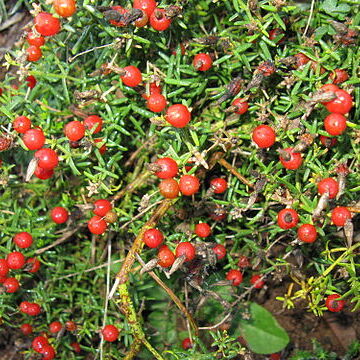Suffrutex, bushy or diffuse, sometimes straggling, about 45 cm high, sometimes up to 1 m high; branchlets intricate or lax, angled or narrowly winged, minutely pellucid-papillose to a greater or lesser degree. Leaves thin to somewhat fleshy, sessile, semi-clasping at the base, linear to linear-oblong, 5-20 mm long, 1-2.5 mm broad, rarely up to 4 mm broad, divaricately spreading to reflexed from the base; margins revolute often minutely papillose, decurrent on the branchlets; upper surface convex with irregular transverse corrugations; midrib impressed above, prominent beneath, decurrent on the branchlets; lower surface minutely papillose; apex broadly rounded or abruptly acuminate into an acute, hooked acumen. Flowers solitary, terminal, or in a 1-3-flowered terminal cyme. Pedicels varying in length, sometimes on the same plant, 2-2.5 mm long, with 6 or more acute longitudinal ridges. Calyx divided to below the middle, shorter than or up to about as long as the corolla tube; tube up to 1 mm long; lobes deltoid to deltoid-ovate or ovate-oblong 1.5-4 mm long, subacute to acute, apex usually hooked, carinate or midrib prominent, decurrent on the pedicel. Corolla pink, 1-1.5 cm long, deciduous by an uneven break near the base, gradually moving off the developing fruit; tube 3-5 mm long, distinctly narrowed above the ovary into a pale collar-like portion and then widening at the mouth; lobes contorted, obovate-oblong, 4.5-9 mm long, 2-4 mm broad, broadly rounded at the apex, sometimes unequally shallowly lobed or notched. Stamens inserted on the tube where it narrows above the ovary; filaments 2.5-4.5 mm long; anthers straight, erect, oblong, bright green or bright yellow, 2-4.5 mm long. Ovary globose, 1-celled, ovules numerous with parietal placentation; style 5-9 mm long; stigma terminal rounded, sometimes faintly 2-cleft. Fruit red when mature, drying black, globose to oblong-globose, berrylike in appearance, splitting irregularly; seeds many, black, pitted, arranged along thick parietal placentas (rarely a specimen of hybrid origin develops a large oblong fruit, broadly acuminate at the apex ).
More
Perennial suffrutex, 0.1-1.0 m high. Leaves thin to ± fleshy, sessile, linear to linear-oblong, up to 20.0 x 2.5 mm. Flowers solitary, terminal or in 1-3-flowered cyme. Corolla pink, 10-15 mm long, gradually decreasing over developing fruit; tube narrowed above ovary, widening at mouth; lobes contorted. Stamens 5, arising from throat of corolla; anthers bright green or yellow. Ovary globose, 1-locular, placentation parietal, ovules many. Flowering time Aug.-Mar. Fruit a globose, berry-like capsule, splitting irregularly, red when mature, drying black. Seeds many, black, pitted.
A small shrub. It grows 1 m tall. The branches can be angled or with wings. The leaves are narrow and spreading. They are 5-20 mm long by 1-2.5 mm wide. The edges are curved. The flowers occur singly at the ends of branches. They are pink. The fruit are red when ripe. There are many seeds.
Shrublet, up to 1 m tall. Leaves linear, spreading. Flowers pink, corolla tube 3-5 mm long, constricted into a collar-like neck above ovary, stigma truncate. Fruit ± globose, berry-like, red.
Shrublet to 1 m. Leaves linear, spreading. Flowers pink, corolla tube 3-5 mm long, constricted above ovary, ovary and fruits rounded, stigma truncate. Fruits berry-like.

